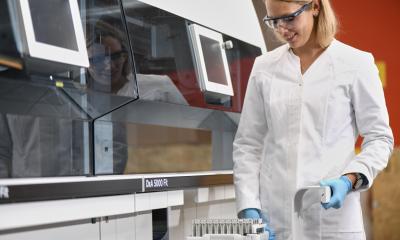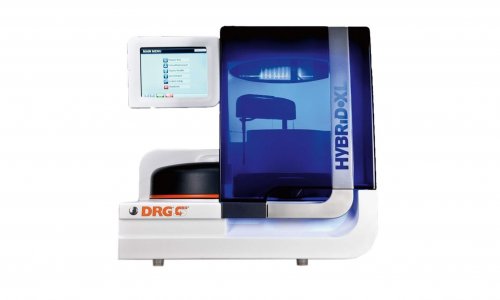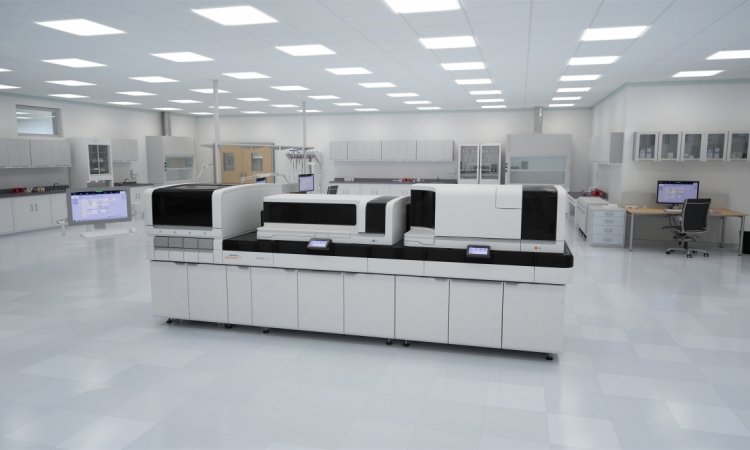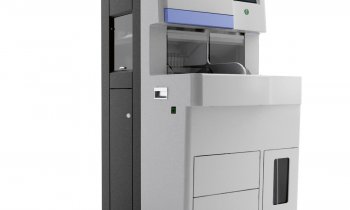Interview • Quality aspects
Lab automation – economic aspects and Covid-19
The academic teaching Karlsruhe Hospital, at the University of Freiburg, is the largest hospital providing tertiary care in the Middle Upper Rhine Valley. Every year, 63,000 in-patients and 180,000 out-patients are treated in the 1,500-bed facility with 50 departments and 30 out-patient clinics. Inevitably, a hospital of this size has a central lab.
Interview: Walter Depner
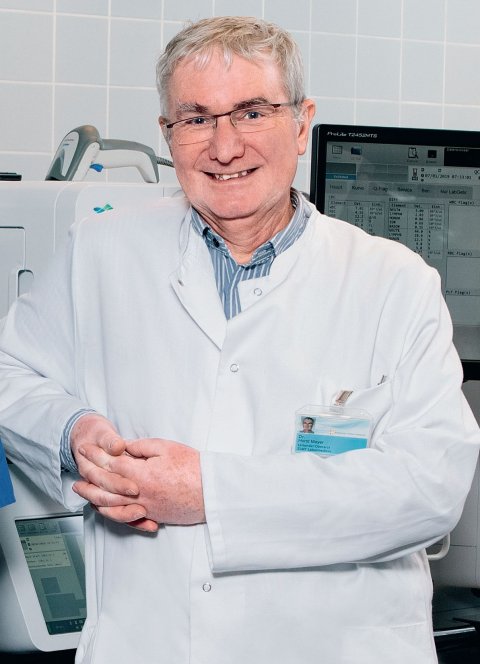
We spoke with Dr Horst Mayer, managing senior physician of the Department of Clinical Diagnostics, about the lab and particularly automation, introduced there over recent years. The effects on the lab of Covid-19 were also explored.
Currently, the hospital has 38 full-time employees and 12 full-time support staff – mainly students. The trauma and emergency department admits about 35,000 adult patients per annum. ‘Each day, we process on average 4,000 samples, of which approximately 1,500 are serum, 500 are coagulation and 800 are blood tests,’ explained Mayer, speaking of the lab’s involvement. ‘The remainder is made up of all other materials. In toto, this amounts to 16,000 analyses per day. Peak times are between 7-9 am. In that window we receive 800 samples; the rest is spread more or less evenly over the day.’
EH: A hospital lab usually processes more pathology samples than non-hospital labs. Is this the case in Karlsruhe?
Mayer: ‘Indeed. Here, about 30 percent of the individual samples are pathology samples; in a non-hospital lab group this would be about five percent.’
Over recent years, hospital length of stay has decreased, while throughput has increased, increasing the number of samples and encouraging automation. Does that mean there is less time for analytics?
‘Definitely. We started automation more than ten years ago with a Siemens Flexlab. This automated lab system generated major benefits, because it could be operated even with a very small team. It ran 24/7 and made a marked improvement because length of stay decreased and throughput increased. The new lab system, which has been installed since, offers even shorter turn-around times as well as significant quality improvements. In fact, at this point we are not running to capacity.’
Not all areas present themselves for the same degree of automation. What is the situation in Karlsruhe? Where did you start automation and where could the most significant effects be realised?
‘Obviously, there are limits to what is feasible. In terms of technology we could link a Sciex 5600 mass spectrometer to the lab system. However, I don’t consider this particularly useful at this point. Assays, which are currently performed as ELISA on MT, that is microtiter plate basis, but which can be done in an immunoassay analyser linked to the system, are all transferred.’
If you rank clinical disciplines by degree of automation, where would you place clinical chemistry?
In a nutshell: traditional clinical chemistry in its current form will have become obsolete
Horst Mayer
‘Indeed we do old-school clinical chemistry, around the clock – tumour markers, hormones and infection serology. Currently, I still consider conventional clinical chemistry relevant. Going forward, however, I think this will change over the next 10 to 15 years. Current resource-intensive methods will be replaced by molecular biology analyses, in particular their miniaturisation will be influential. In a nutshell: traditional clinical chemistry in its current form will have become obsolete.’
How did your staff structure change due to automation? Did you have to or were you able to switch staff?
‘When we installed the first automated lab system in 2009, we were lucky because the four employees who became redundant retired – we did not have to replace them. Over the course of time we reduced the team in the core lab and transferred some team members to special diagnostics, haematology, coagulation or areas such as serology or toxicology.’
A hospital lab always reflects the foci and departments of an institution as a whole. In your case, paediatric and adult oncology are major departments. How does this affect your lab?
‘We see a significant demand by the oncology departments and this plays a major role in the lab. We were able to transfer several of the clinical chemistry staff mentioned above to oncology. In haematology, we have a Sysmex system with digital morphology followed by flow cytometry. Among the areas that are not part of the central lab are molecular biology, where PCRs for oncology and pathology are performed.’
Image source: Shutterstock/xiao yu
Talking about PCR: how does Covid-19 affect your lab?
‘Not so much. We do have a full Cobas 6800 system. The main issue, however, is the fact that we don’t have enough tests. Currently, we use Corona antibody tests.’
Do you only test your own patients and staff or do you also receive samples from outside to process?
‘We receive very few external samples from office-based physicians. Our problem is the fact that non-hospital labs receive priority for tests. We only receive about 1,000 test units per week for molecular biology. Technically, we would have the capacities for many more tests. I personally was not tested, since the lab is considered a closed-off zone. The situation is obviously very different for our patients and the care staff.’
Profile:
Formerly a laboratory physician in Magdeburg, Germany, 20 years ago Dr Horst Mayer joined the Department of Clinical Diagnostics at Karlsruhe Hospital, where he became managing senior physician.
09.11.2020



